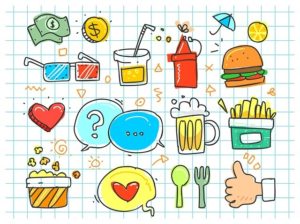Eating Disorders In Men
 We live in a society where food has many meanings. We use it not only to nourish our bodies but to manage our emotions. It is both comforting and stimulating. It makes us happy and calms our nerves.
We live in a society where food has many meanings. We use it not only to nourish our bodies but to manage our emotions. It is both comforting and stimulating. It makes us happy and calms our nerves.
Eating may be an art form for some, a pleasurable social activity for many but for others it can be an agonizing process of regret, pain and self-recrimination.
As bizarre as that may sound to someone who has no trouble with food, to a person with an eating disorder that statement rings true.
By some estimates there are at least 8-10 million people with eating disorders. This is probably a very low estimate.
Broadly speaking an eating disorder is a severe disturbance in a person’s eating habits. When a person seems to no longer have control over their ability to eat normally he is said to have an eating disorder.
Eating disorders in men is one of those topics you don’t often hear about. Nevertheless, the problem has been growing steadily in the male population.
Male Eating Disorders
Myth: Eating disorders such as Anorexia Nervosa and Bulimia Nervosa occur only in the female population.
Fact: Recent research has shown that perhaps as many as 1 in 4 (25%) of people with eating disorders are male.
Myth: Men who suffer from Anorexia and Bulimia are mostly homosexual.
Fact: Upwards of 80% of the men with Anorexia and Bulimia are heterosexual.
How Eating Disorders Develop
Cultural pressures and media attention focusing on the perfect body impact all of us, regardless of gender. We are bombarded with images of beauty and glamour, both female and male, which tend to warp the way we see ourselves.
Add to that some predisposing factors such as: brain activity (dopamine receptors in the brain are linked to Anorexia), a history of obesity in one’s family, an early emphasis on body image or even a desire to compete in athletics and we have the underpinnings of an eating disorder in the making.
Three types of eating disorders:
- Anorexia Nervosa (obsessive fear of gaining weight)
- Bulimia Nervosa (binge eating followed by purging)
- Compulsive Overeating (a type of food addiction characterized by binge or uncontrolled eating).
An Equal Opportunity Disorder
Suffering with an Eating Disorder has been viewed largely as the domain of the female.
People see it as a “girls” disease, thereby carrying a stigma for men. It is only in recent years that this problem has been identified as occurring in large numbers in males as well.
In our society women tend to discuss their emotional issues more openly and more often than men. Many men either don’t see themselves as having emotional problems or are in denial, especially when it comes to an eating disorder.
When a man realizes that he is dealing with an eating disorder he will often feel humiliated or ashamed, thereby intensely guarding that secret.
Male Symptoms Of Eating Disorder VS. Female Symptoms
There are some symptomatic differences between men and women. Whereas women tend to focus on calories and weight, men tend to obsess over muscle and body fat.
Women tend to use laxatives more often than men to control weight. Men tend to over exercise to offset overeating more often than women.
Women with eating disorders want to be slim as their goal. Men on the other hand may want to be slim or heavily muscled, depending upon the body image most appealing to them.
On the surface men appear to be more comfortable with their bodies. Women will sometimes comment that men seem not to care as much as they do about how they look.
However, there is a general emphasis, often by the media, on dieting and shapeliness for females and physical fitness and muscles for men. Younger men, in particular, can be obsessed with having a “six pack” and being heavily muscled or buff, or lean and lanky like the model or rock star they admire.
Men and Body Distortion
 Body builders are perhaps the most notorious of men with body image obsession. It is a vanity sport with heavy emphasis on shape and size. Eating becomes a primary focus and choice of foods a total preoccupation.
Body builders are perhaps the most notorious of men with body image obsession. It is a vanity sport with heavy emphasis on shape and size. Eating becomes a primary focus and choice of foods a total preoccupation.
Here a man’s eating habit can go from near starvation to compulsive overeating in a very short time.
This is also the case with many competitive athletes who are driven by a need to regulate caloric and fat intake in an effort to perform at the highest levels.
Bigorexia
Many men suffer from a type of disorder called Bigorexia, or Muscle Dysmorphia which is a type Body Dysmorphia, the opposite of Anorexia.
There is an obsession with being too small, slender or fragile. The man sees himself as being underdeveloped and will go to any lengths to get bigger, often risking his health by using drugs such as steroids or human growth hormone.
Apart from competitive athletics, the need to look svelte, athletic, powerful, muscular or manly can drive a man to diet mercilessly. If he is unable to achieve his fantasy self, he may fall into a depressed mood and begin binge eating to feel better. Binge eating or compulsive overeating as a reaction to the failure to achieve an ideal body type may bring with it an even deeper decline into depression.
Alcohol and or substance abuse is also found to be prevalent among men with eating disorders. This can be viewed as a form of self-medicating for depressed or anxious mood. Eating disorders are often associated with depression, anxiety and generally low self-esteem.
An eating disorder can pose very real dangers to the health and life of its victim. This disorder, for both males and females, generally starts early, in the teen years, and can continue for many years thereafter.
Since men are typically overlooked as likely to have this problem, they can go on for a long time without anyone identifying it.
The lack of research about male eating disorders is reflective of the fact that most men do not seek help for it. It is seen as a feminine or gay problem by many men. Men tend to view it as a weakness and are reluctant to talk about it.
Although this issue can be viewed as a compulsive behavior, it can also fall into a type of obsessive-compulsive disorder (OCD). Either way it can be treated.
Effective treatment may include medication, an in patient rehab facility, group therapy and individual therapy.
Other articles of interest:
The Top 10 Signs of Midlife Crisis
Midlife Crisis and Male Menopause: Men and Sex
About the Author
Dr. Stan Hyman is a licensed psychotherapist and life coach in private practice in Miami, Florida. His work with men includes helping them work through life changes as well as performing at higher levels while creating a better balance in their personal lives. He also works with couples struggling with powerful issues such as infidelity, careers and intimacy. He also specializes in treating addictions, anger, anxiety, compulsive behaviors, stress, depression and work life balance.
